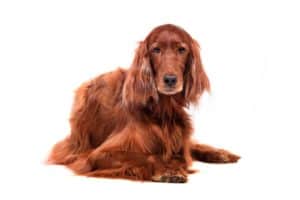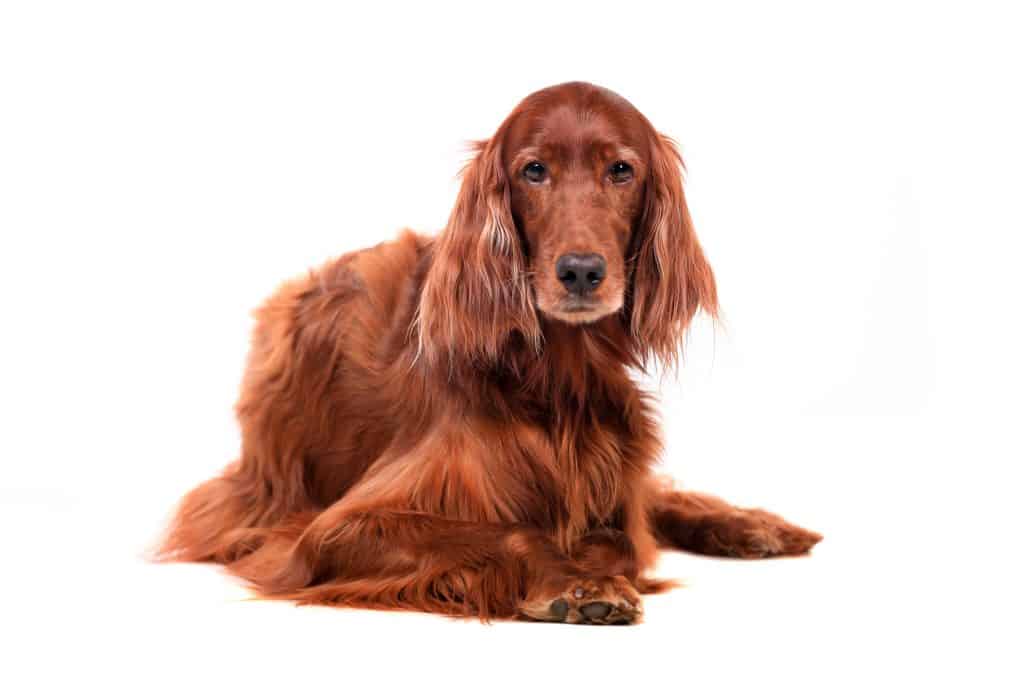 Relatively easy to groom the coat of an Irish Setter. The hair on the head, front of legs and tips of the ears is short and fine; on all other parts of the body and legs it is of moderate length, flat and as free as possible from curl or wave.
Relatively easy to groom the coat of an Irish Setter. The hair on the head, front of legs and tips of the ears is short and fine; on all other parts of the body and legs it is of moderate length, flat and as free as possible from curl or wave.
Feathering on the ears is long and silky. On the back of the forelegs and on the hindlegs, the hair is long and fine, with a fair amount of hair on the belly, forming a fringe which may extend to the chest and throat. The feet are well feathered between the toes of this dog, though generally these are trimmed round to neaten. The tail fringe is of moderate length, decreasing as it approaches the tip or point.
The Grooming Process
Equipment needed: A good-quality bristle brush, a pin brush to use where necessary, a wide-toothed metal comb and a finer comb for finishing.
Breed tip: Over-trimming will spoil the classic look, so any hairdressing must be carefully executed.
- Brush thoroughly with a good-quality bristle brush. Long hair can be tackled with a pin brush where required, to remove tangles.
- Comb with a wide-toothed metal comb to remove dead hair. A finer comb can then be used if more hair needs to be removed.
- Bathe the dog in a suitable mild shampoo.
- Use conditioner after rinsing thoroughly. A purifying shampoo and mask can be applied three times a year to enhance the skin and coat.
- The coat is blow-dried with the growth of the hair to keep it flat and sleek, rather than lifted and flyaway. This can be achieved by pointing the blower downwards over the dog. Spray conditioner will assist this process and leave the coat gleaming.
- Check the dog’s nails, ears and teeth.
- Trimming to enhance a natural appearance, while emphasizing angulation and the good points of the dog, is undertaken as follows. Groomers inexperienced in this breed would be well advised to take expert advice on trimming particular dogs for the show ring, as every dog is different, and too much or too little trimming can spoil the overall picture of the dog.
- Head: excess hair is plucked out with finger and thumb to give the head a smooth finish.
- Neck: using thinning scissors, thin from the throat to just above the breastbone, with the growth or lie of the hair. Trim from the underside of the ear to the center of the breastbone. The surrounding hair is blended with thinning scissors or shears to give a smooth, clean, natural appearance. Do not use thinning scissors across the grain of the coat, as this will leave a cutting, doorstep effect; only trim in the direction that the coat grows. The chest feathering falls from the breastbone to the fall of hair on the upper part of the front legs.
- Ears: thinning scissors are used on the inside and outside of the leathers, working downwards with the hair growth, to shorten the hair to a very neat appearance, removing the excess coat on the neck beneath the ear to blend in and flatten the coat. Trim around the leather to finish.
- Body: thoroughly comb through the body hair, working down the fringe of the chest to remove dead hairs and give a smooth, sleek appearance. First, use a medium-toothed comb and then a finer one if required.
- Front feet: the feet are trimmed underneath to remove excess hair, working an inch or so up the leg. Tidy around the toes with thinning scissors to give a neat appearance. Between the toes, it is beneficial to thin the excess hair to prevent it from becoming clogged with mud, etc.
- Back feet and hock: trim the rear feet following the same procedure as for the front ones, to give a neat appearance. Comb the hair from the point of the hock upwards to the toes. Using thinning scissors in a downward action, remove the hair to give a flat, clean finish.
- Tail: this is trimmed to a moderate length, with the hair decreasing in a taper to the tip or point.
- The use of clippers may be undertaken when the coat has blown, and becomes extremely thick and unmanageable, as with a neutered pet for example. Clipping the Irish Setter should only be carried out as a very last resort.

